Image Transfer to FTP Servers
- Configuring FTP Server Connection Settings
- Transferring Images Individually
- Transferring Multiple Images at Once
- Adding a Caption Before Transfer
- Auto Retry If Transfer Fails
- Viewing Transferred Images
By connecting to an FTP server, you can send images on the camera to a computer.
With FTP transfer, you can automatically transfer each image to the FTP server as you shoot or transfer a set of images together.
Note
- JPEG/HEIF images can be resized or cropped during the transfer process.
Configuring FTP Server Connection Settings
These instructions are continued from Configuring Communication Function Settings.
-
Select an FTP mode.

- [SFTP] is not displayed when the camera will connect via Wi-Fi.
- For secure FTP transfer using a root certificate, select [FTPS]. For details on root certificate settings, see Importing a root certificate for FTPS.
- For secure FTP transfer over an SSH connection, select [SFTP]. Login settings are configured in step 5.
- Select [OK] to go to the next screen.
-
Select [Address setting].
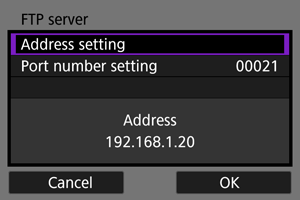
- Select [OK] to go to the next screen.
- The virtual keyboard is displayed if you have specified [Auto setting] for the IP address or [Manual setting] for the DNS address.
- A screen for numerical input is displayed if you have specified [Disable] for the DNS address.
-
Enter the FTP server IP address.
Virtual keyboard
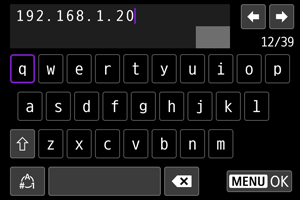
- Use the virtual keyboard () to enter the IP address. If DNS is used, enter the domain name.
- To set the entered values and return to the screen for step 2, press the
button.
Numerical input screen

- Turn the
dial to switch to other input fields at the top of the screen, and turn the
dial to select numbers to enter. Press
to enter the selected number.
- To set the entered values and return to the screen for step 2, press the
button.
-
Configure the port number.

- Normally, set [Port number setting] to 00021 (for FTP/FTPS) or 00022 (for SFTP).
- Select [OK] to go to the next screen.
- Go to step 6 if you selected [FTP] or [FTPS] in step 1. Go to step 5 if you selected [SFTP].
-
Configure the SSH login authentication settings.

-
Configure the passive mode setting.
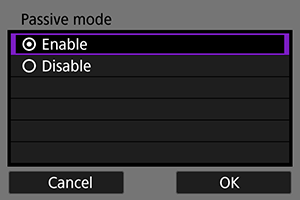
- Not displayed if you selected [SFTP] in step 1.
- Select [OK] to go to the next screen.
- If an Error 41 (Cannot connect to FTP server) is displayed in step 9, setting [Passive mode] to [Enable] may resolve it.
-
Configure proxy server settings.
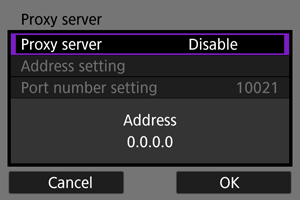
- Not displayed if you selected [FTPS] or [SFTP] in step 1.
- Select [OK] to go to the next screen.
-
Configure the login method.
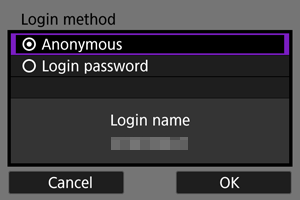
- Not displayed if you selected [SFTP] in step 1.
- Select [OK] to go to the next screen.
-
Specify a target folder.
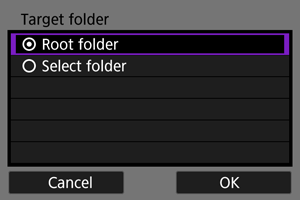
- Select [Root folder] to have images saved in the root folder, as specified in FTP server settings ().
- Select [Select folder] to specify a target folder in the root folder. If the folder does not exist, it is created automatically.
- Select [OK] to go to the next screen.
- The camera's
lamp is lit in green.
-
When the following message appears, select [OK] to trust the target server.

-
Select [OK].

- Not displayed in offline configuration.
-
Select [OK].
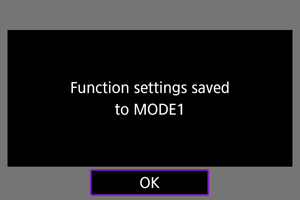
-
Select [OK].
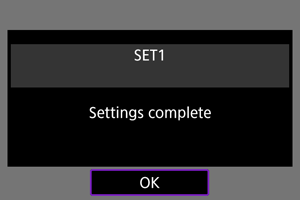
- Display returns to the [Network settings] screen.
Connection settings for FTP transfer are now complete.
During image transfer, the camera's lamp blinks in green.
Importing a root certificate for FTPS
If you specified [FTPS] FTP mode when configuring connection settings, the root certificate used by the FTP server must be imported to the camera.
- Only the root certificate with a file name of “ROOT.CER,” “ROOT.CRT,” or “ROOT.PEM” can be imported to the camera.
- Only one root certificate file can be imported to the camera. Insert a card containing the root certificate file in advance.
- The priority card selected for [Record/play] or [Playback] in [
: Record func+card/folder sel.] is used to import a certificate.
- It may not be possible to trust servers you try to connect to in FTPS connections with a self-signed certificate.
-
Select [
: Network settings].
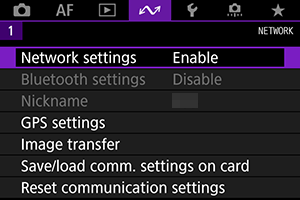
-
Select [Connection option settings].
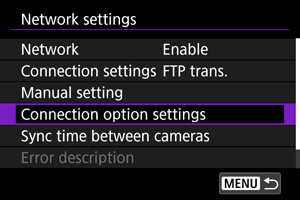
-
Select [FTP transfer settings].

-
Select [Set root certif].

-
Select [Load root certif from card].
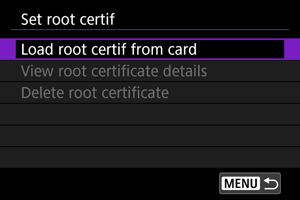
-
Select [OK].

- The root certificate is imported.
- Select [OK] on the confirmation screen to return to the [Set root certif] screen.
Note
- To delete the root certificate imported to the camera, select [Delete root certificate] on the screen in step 5. To check who it was issued to and issued by, the period of validity, and other information, select [View root certificate details].
Transferring Images Individually
Automatic transfer after each shot
Each image can be immediately transferred to the FTP server automatically after your shot. You can continue shooting still photos as usual while images are being transferred.
- Before shooting, make sure a card is in the camera. If you shoot without recording images, they cannot be transferred.
- Automatic transfer of movies during recording is not supported. After recording, transfer movies as described in Transferring Multiple Images at Once or Adding a Caption Before Transfer.
-
Select [
: Network settings].

-
Select [Connection option settings].
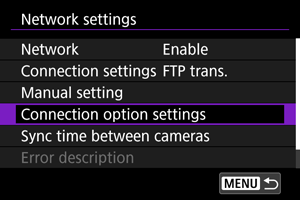
-
Select [FTP transfer settings].
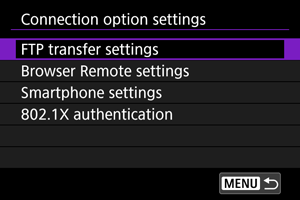
-
Select [Automatic transfer].
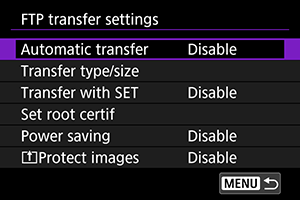
-
Select [Enable].
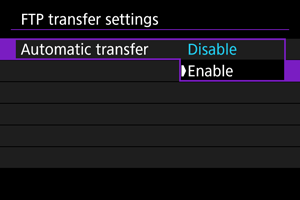
-
Take the picture.
- The captured image is transferred to the FTP server.
Caution
- Images cannot be erased during image transfer.
- No voice memo can be added when [Automatic transfer] is set to [Enable].
Note
- During continuous shooting, images are transferred to the FTP server in the order they are captured.
- Captured images are also stored on the card.
- Any images for which transfer fails or is interrupted will be transferred automatically when the connection is recovered (). These images can also be transferred together manually at a later time ().
- Repeated automatic transfer is not attempted if network settings (such as FTP server settings) are changed before automatic FTP transfer begins.
Transferring the current image
Enables you to transfer the image you are viewing simply by pressing . You can continue shooting still photos as usual while images are being transferred.
-
Access the [FTP transfer settings] screen.
- Follow steps 1–3 in Automatic transfer after each shot.
-
Select [Transfer with SET].
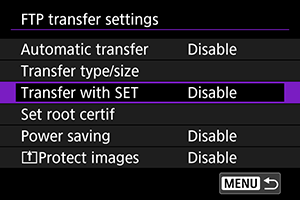
-
Select [Enable].
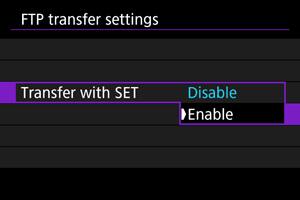
-
Select an image.
- On the camera, press the
button.
- Select an image to transfer, then press
to transfer the image.
- You can add a voice memo to the current image before transfer. For details, see Recording Voice Memos.
- Movies cannot be transferred this way. Selecting a movie and pressing
will display the movie playback panel.
- On the camera, press the
Specifying sizes or types of images to transfer
You can specify which images to transfer when recording images of different sizes to the CFexpress cards, or when shooting RAW+JPEG or RAW+HEIF images.
-
Access the [FTP transfer settings] screen.
- Follow steps 1–3 in Automatic transfer after each shot.
-
Select [Transfer type/size].
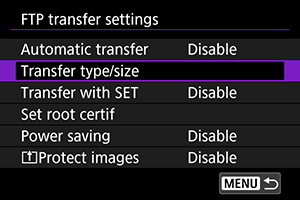
-
Select the size of images to transfer.
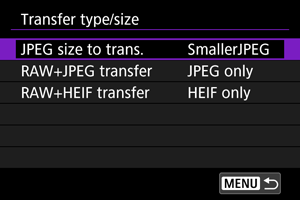
-
Select [JPEG size to trans.], then select [Larger JPEG] or [SmallerJPEG].
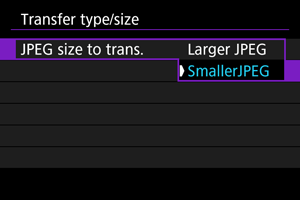
- To transfer smaller JPEGs when the camera is set to record larger JPEGs to one CFexpress card and smaller JPEGs to the other, set [JPEG size to trans.] to [SmallerJPEG].
-
-
Select the type of images to transfer.
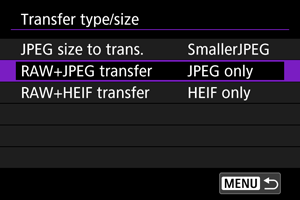
-
RAW+JPEG transfer
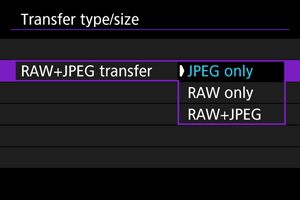
- Select [RAW+JPEG transfer], then select [JPEG only], [RAW only], or [RAW+JPEG].
-
RAW+HEIF transfer
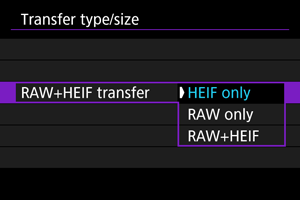
- Select [RAW+HEIF transfer], then select [HEIF only], [RAW only], or [RAW+HEIF].
-
Note
- When the camera is set to record RAW images to one CFexpress card and JPEGs or HEIFs to the other, specify which images to transfer in the [RAW+JPEG transfer] or [RAW+HEIF transfer] setting. Similarly, specify your transfer preference when RAW+JPEG images or RAW+HEIF images are simultaneously recorded to a single card.
- Captured images are also stored on the card.
- When images of the same size are recorded to both cards simultaneously, images recorded to the card selected for [
Record/play] or [
Play] in [
: Record func+card/folder sel.] are given priority for transfer.
Transferring Multiple Images at Once
After shooting, you can select multiple images and transfer them all at once, or you can transfer unsent images or images that could not be sent previously.
You can continue shooting still photos as usual during transfer.
Caution
- Image transfer in progress is paused while the Live View shooting/movie shooting switch is set to
. To resume image transfer, set it to
.
Selecting images to transfer
-
Select [
: Image transfer].
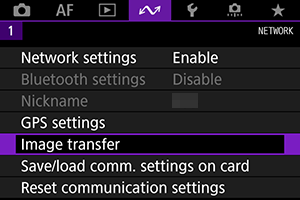
-
Select [Image sel./transfer].
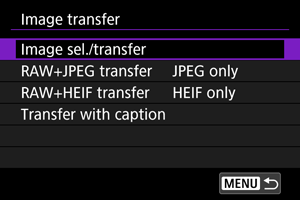
-
Select [FTP transfer].
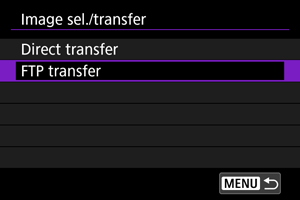
-
Select [Sel.Image].
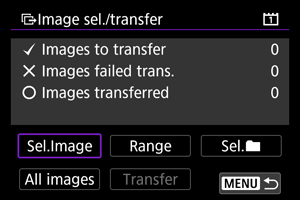
-
Select the images to transfer.
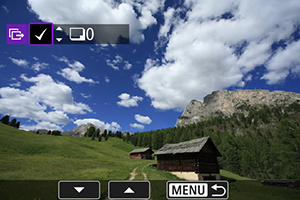
- Use the
dial to select an image to transfer, then press
.
- Use the
dial to add a [
] in the upper left, then press
.
- For three-image display, press the
button and turn the
dial left. To return to single-image display, turn the
dial right.
- To select other images to transfer, repeat step 5.
- After image selection, press the
button.
- Use the
-
Select [Transfer].
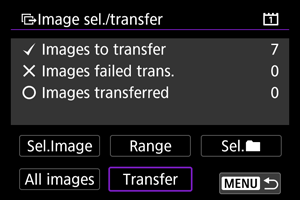
-
Select [OK].
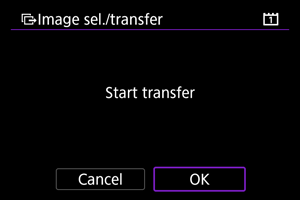
- The selected images are transferred to the FTP server.
Selecting multiple images
Multiple images can be transferred at once after you choose a selection method. You can continue shooting still photos as usual while images are being transferred.
-
Access the [Image sel./transfer] screen.
- Follow steps 1–3 in Selecting images to transfer.
-
Select a selection method.

In a folder
- Select [Sel.
].
- Select your preferred selection method.

- Selecting [Select transfer failed images] selects all images in the selected folder for which transfer failed.
- Selecting [Select images not transferred] selects all unsent images in the selected folder.
- Selecting [Sel transfer fail img (
only)] selects all protected images in the selected folder for which transfer failed.
- Selecting [Sel img not transfer. (
only)] selects all unsent protected images in the selected folder.
- Selecting [Clear transfer history] clears the transfer history of images in the selected folder.
- After clearing the transfer history, you can select [Select images not transferred] and transfer all images in the folder again.
- After clearing the transfer history, you can select [Sel img not transfer. (
only)] and transfer all protected images in the folder again.
- Select a folder.
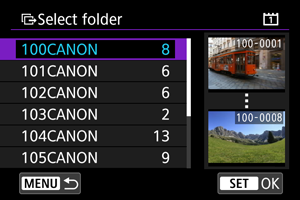
- Select [OK] to transfer the selected images to the FTP server.
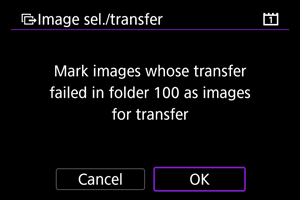
In a card
- Select [All images].
- Select your preferred selection method.
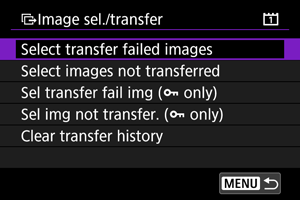
- Selecting [Select transfer failed images] selects all images on the card for which transfer failed.
- Selecting [Select images not transferred] selects all unsent images on the card.
- Selecting [Sel transfer fail img (
only)] selects all protected images on the card for which transfer failed.
- Selecting [Sel img not transfer. (
only)] selects all unsent protected images on the card.
- Selecting [Clear transfer history] clears the transfer history of images on the card.
- After clearing the transfer history, you can select [Select images not transferred] and transfer all images recorded on the card again.
- After clearing the transfer history, you can select [Sel img not transfer. (
only)] and transfer all protected images recorded on the card again.
- Select [OK] to transfer the selected images to the FTP server.

Select range
- Select [Range].
- Selecting the first and last images of the range marks all the images in the range with a checkmark [
], and one copy of each image will be sent.
- After image selection, press the
button.
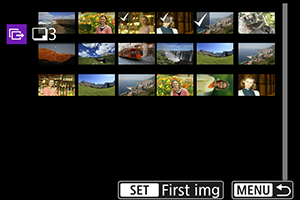
- Select [OK] to transfer the selected images to the FTP server.
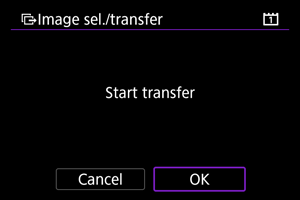
Transferring RAW+JPEG or RAW+HEIF images
For RAW+JPEG or RAW+HEIF images, you can specify which image to transfer.
-
Select [
: Image transfer].
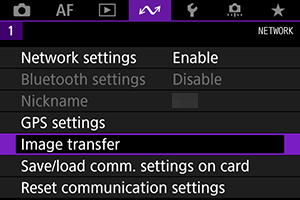
-
Select the type of images to transfer.
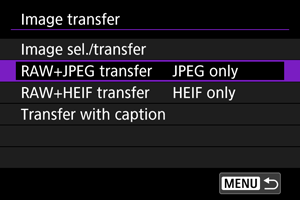
-
RAW+JPEG transfer
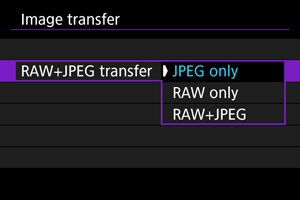
- Select [RAW+JPEG transfer], then select [JPEG only], [RAW only], or [RAW+JPEG].
-
RAW+HEIF transfer

- Select [RAW+HEIF transfer], then select [HEIF only], [RAW only], or [RAW+HEIF].
-
Caution
- Some menu items are not available during image transfer.
Adding a Caption Before Transfer
You can add a registered caption to each image before transfer. This is convenient if you want to inform the recipient of the printing quantity, for example. Captions are also added to images saved to the camera.
-
Select [
: Image transfer].
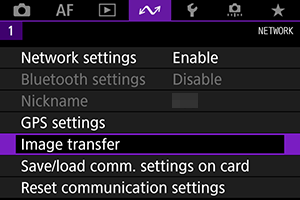
-
Select [Transfer with caption].
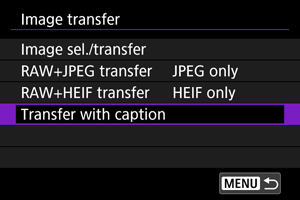
- The last image viewed is displayed.
-
Specify the caption.
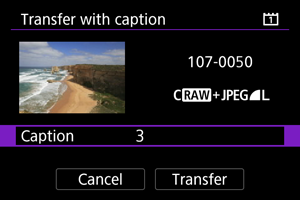
-
Select [Caption], and on the screen displayed, select the content of the caption.
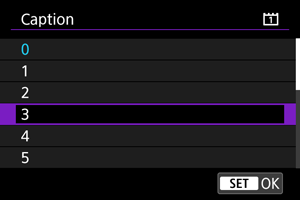
-
-
Select [Transfer].
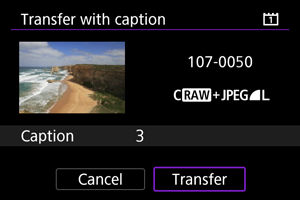
- The image is transferred with the caption. After transfer, display returns to the [Image transfer] screen.
Caution
- Other images cannot be selected from the [Transfer with caption] screen. To select another image for transfer with a caption, view that image before following these steps.
Auto Retry If Transfer Fails
If transfer fails, the camera's lamp blinks in red. In this case, the following screen is displayed after you press the
button and select [
: Network settings].
To resolve the error displayed, see Troubleshooting.
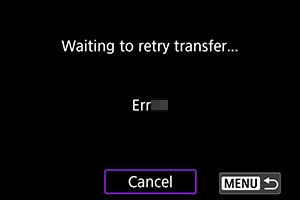
Once you have resolved the issue, the images that could not be sent initially will be transferred automatically. With this option activated, transfer is attempted again automatically after failure, whether automatic transfer is used or captured images are transferred manually via FTP. Note that if you cancel transfer or turn the camera off, auto retry is not attempted.
See Transferring Multiple Images at Once and transfer images as needed.
Viewing Transferred Images
Images transferred to the FTP server are stored in the following folder as specified in the FTP server settings.
-
Target folder of the FTP server
- Under the default settings of the FTP server, images are stored in [C drive] → [Inetpub] folder → [ftproot] folder, or in a subfolder of this folder.
- If the root folder of the transfer destination has been changed in the FTP server settings, ask the FTP server administrator where images are transferred.